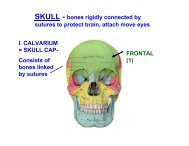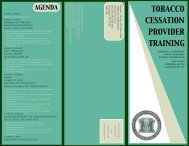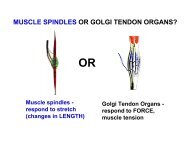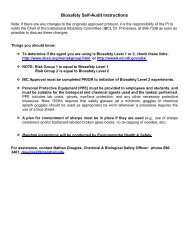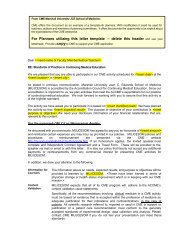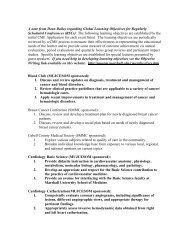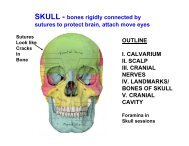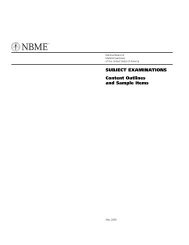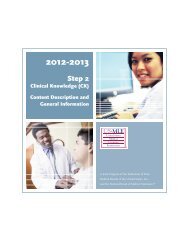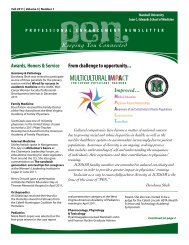FA 5 Progress Report WV-INBRE - Joan C. Edwards School of ...
FA 5 Progress Report WV-INBRE - Joan C. Edwards School of ...
FA 5 Progress Report WV-INBRE - Joan C. Edwards School of ...
- No tags were found...
Create successful ePaper yourself
Turn your PDF publications into a flip-book with our unique Google optimized e-Paper software.
Program Director/Principal Investigator (Last, First, Middle): Rankin, Gary O 41EFFECT OF STRESS ON PATHOGENESIS AND IMMUNITY DURING CHLAMYDIAGENITAL INFECTION (0039)TYPE:Research Subproject%IDeA $: 5.000% IDeA $: 174,247INVESTIGATOR, DEGREEBelay, Tesfaye PHDYu, Hongwei PHDDEPARTMENTBiological SciencesBiochemistry &MicrobiologyNON-HOST INSTITUTION: STATE,COUNTRYBluefield State College, Wv UsaTotal # human subjects expected for entire study: 0Total # human subjects enrolled to date: 0SUBPROJECT DESCRIPTIONGenital infection by Chlamydia trachomatis is the most common bacterial sexually transmitted disease (STD)worldwide. The fact that not all infected women develop chlamydia-induced sequelae would suggest thatcertain socio-biological factors such as stress status may contribute to how an infection evolves intocomplications. However, the effect <strong>of</strong> stress on the susceptibility, intensity and complication <strong>of</strong> chlamydialinfection are unknown. The central objective <strong>of</strong> this proposal is to utilize a reliable mouse model <strong>of</strong> coldstressand genital chlamydia infection that reproduces the pathological and immunological processes in humans toinvestigate the effect and mechanism(s) <strong>of</strong> stress-induced hormones on: (a) the susceptibility to and intensity<strong>of</strong> genital chlamydial infection; (b) the development <strong>of</strong> pathologies such as tubal inflammation and infertility;and (c) the host innate and acquired immune responses to Chlamydia. Our hypothesis is that cold-stressincreases the severity <strong>of</strong> chlamydia genital infection and development <strong>of</strong> complications by modulating theimmune response against Chlamydia. Based on our preliminary results, we predict that coldstressapplication leads to decreased resistance to chlamydia genital infection via induction <strong>of</strong> elevated stresshormones that are immunosuppressive. Aim #1 will continue analyzing the effect <strong>of</strong> cold water stress on thecytokine, chemokine and receptor dynamics in mice infected intravaginally with Chlamydia and assess theinfluence <strong>of</strong> cold-stress on the trafficking and distribution <strong>of</strong> immune cells in different regions <strong>of</strong> the genitaltract during genital chlamydial infection. Aim #2 will continue determining the effect <strong>of</strong> cold water stress onascending chlamydial infection and the histopathological changes <strong>of</strong> the genital tract <strong>of</strong> infected animals. Aim#3 will continue directly assessing the effect <strong>of</strong> cold-stress on Chlamydia-induced infertility by determiningthe effect on pregnancy and number <strong>of</strong> pups. Aim #4 will investigate and define the possible mechanism (s)how Chlamydia clearance is impaired due to the impact <strong>of</strong> releasing NE in our stressmouse model. The findings from this project may aid in developing an approach to reduce complications <strong>of</strong>chlamydal genital infection and ultimately infertility in the host.SUBPROJECT PROGRESSAim #1: To assess the influence <strong>of</strong> stress on distribution pattern <strong>of</strong> immune cells in differentregions <strong>of</strong> the genital tract during Chlamydia trachomatis infectionThe purpose <strong>of</strong> this aim was to determine the localization <strong>of</strong> variety <strong>of</strong> immune cells with surfacemarkers during Chlamydia genital infection within the regions <strong>of</strong> the genital tract <strong>of</strong> mouse stressmodel using flow cytometry analysis. Cells were harvested by collagenase Type 1 treatment <strong>of</strong>genital tract <strong>of</strong> infected mice. Fluorescein-labeled monoclonal antibodies directed against murineCD3, CD4, CD8, CD54 (ICAM-l), CD71, CD 102 (ICAM-2), MadCAM-l, and NK were used to identifythe cell surface markers in the genital tract <strong>of</strong> mice. In general, the total number <strong>of</strong> immune cells instressed mice was reduced; however, no statistically significant difference between stressed andnon-stressed was obtained. Increased infiltration <strong>of</strong> leukocytes into the genital tract <strong>of</strong> stressed ornon-stressed infected mice was obtained. Further flow cytometry experiments are underway tolocalize neutrophils, lymphocytes and dendritic cells or adhesion molecules in the regions <strong>of</strong> thegenital tract <strong>of</strong> stressed mice during chlamydia infection. These data will aid to examine whetherthere is a direct or indirect correlation between immune cells and chlamydia load in the genital tractPHS 2590 (Rev. 06/09)Continuation Format Page



